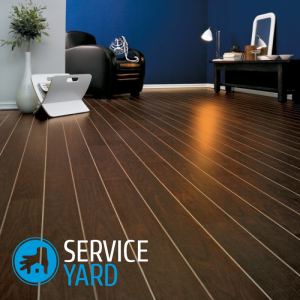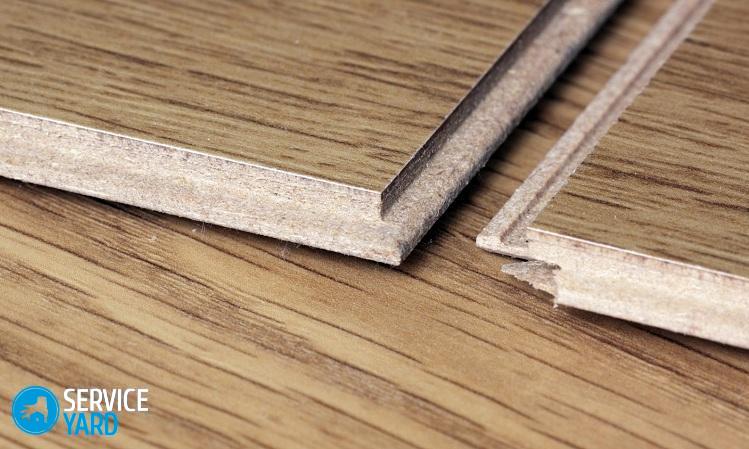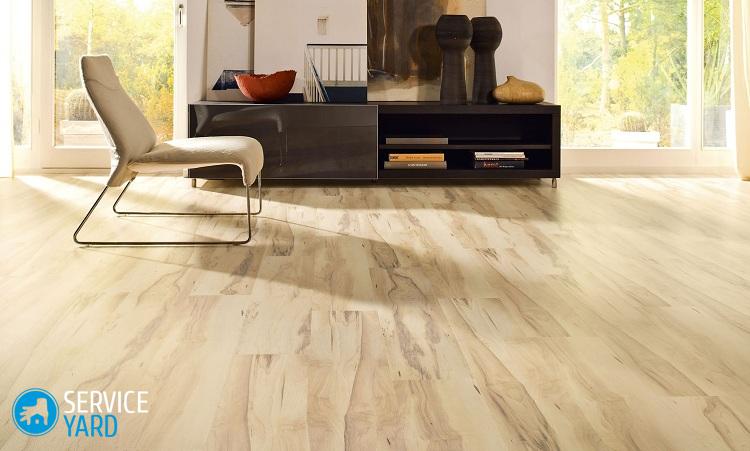How to lay a laminate?

Laminate flooring is a relatively young and at the same time inexpensive type of modern flooring. It attracts general attention with an abundance of textured, colorful options that most accurately imitate the pattern of noble wood, natural stone, even the skin of exotic reptiles. The main reason for buying a laminate flooring is its technological priorities, due to which you can even do your own flooring - just follow some rules, and then the result will be perfect. Today we will consider how to lay a laminate, we will study all the subtleties.
to contents ↑Laminate Long-Term Guaranteed - Leveling
Do-it-yourself laying rules for the laminate require, first of all, the alignment of the rough foundation in accordance with applicable building codes:
- The old concrete floor must be repaired, the cracks widened and filled with cement-sand mortar. Large exfoliated pieces must be removed without fail, and fill the recesses with a special mixture that can level out on its own. After hardening, the floors are ground or poured with a finish screed.
- The cement screed is primed with ceresite so that the surface of the concrete layer is not dusty, and the sand that has separated from the concrete does not creak under the laminate.
- Old wooden floors are simply repaired with the replacement of damaged elements. To reduce the height of the ceilings, the surface is leveled with plywood.
- All irregularities are cut from the plywood base and the new board flooring with a grinder.
to contents ↑Important! Any floor before the laminate is charmingly thoroughly washed and vacuum cleaned from dust.
Decent laminate backing
Laminate - a set of multilayer panels that are equipped with locking systems on four sides. It is very easy and simple to work with it, because it is enough just to snap the device in, and that’s all - no extra effort is required. But in addition to the decorative coating, in order to lay the laminate, you need to purchase related materials. One of them is the substrate.
Why is this needed?
In accordance with the technological rules for laying the laminate and the instructions of the manufacturers, the substrate must perform the following functions:
- Sound insulation, absorption of sounds from steps.
- Providing a certain level of static floor floating surface.
- Protection against abrasion of the inner side in contact with the subfloor.
- Alignment of small defects of the base.
- Protection against moisture from wood floors.
If the foundation itself is too embossed and the differences exceed 2 mm, then quickly enough the finished floors will begin to expand and break. The consequences of this process are very disappointing: the surface will begin to creak, and large cracks will become even larger, will turn into real holes.
Important! Acceptable uniform slope of the plane of the subfloor can be considered 4 mm per 2 square meters. But it is important to note that furniture cannot be placed in such areas - interior items will not be stable, as they will not be able to stand on all 4 legs. As a result, the furniture details will begin to warp and break.
Materials
The substrate for the laminate choose one of the following materials:
- Cork roll coating.
- Coniferous slabs.
- Foam roll material.
- Foamed polypropylene.
- Plate polystyrene foam.
Important! The type of substrate, as a rule, is selected taking into account the class of the laminate itself and the quality of the subfloor.
Dimensions
The thickness of the substrate is determined by the similar size of the panels. Therefore:
- It is recommended to buy a laminate with a thickness of 9 mm and make for it a substrate of 3 mm material.
- If the laminate itself is thicker, respectively - the thickness of the substrate will increase.
In principle, all panels are sold in boxes or rolls, on which there are recommendations of specialists, so it is better to focus on them.
to contents ↑Quality insulation layer
Since the laminate is mainly made from impregnated paper, inexpensive coniferous boards and wood, created by pressing wood processing wastes, it is undesirable for them to come into contact with moisture-generating surfaces. Therefore, before laying the laminate, it is necessary to take care of arranging the vapor barrier layer, which will play the role of a diffuse membrane. Otherwise, excess moisture will be freely transmitted to your neighbors through the concrete floor. As insulation, you can use thick polyethylene.
Important! Only concrete floors are needed for insulation, and the foundations of particleboard, plywood, wood and parquet do not need it. Despite technological differences, concrete floors can be considered:
- Screeds made of cement and sand.
- Concrete floors containing crushed stone or gravel.
- Factory slabs and monolithic floors with round voids.
Actually, the age of the concrete base itself is completely unimportant, because both new and old floors can release and absorb moisture. A well-made insulation will stop any water attempts to penetrate into the laminate, which will warp it from the inside.
to contents ↑Important! They lay stripes with an overlap of 20 cm on the previous sheet. After completing all work with the laminate, polyethylene is simply covered with baseboards.
Laminate laying specifics
Laminate floors are installed according to a floating scheme, that is, they are not attached to the rough base and walls, they are only connected to each other. The layers under the panels are also not attached to anything, they lie freely under the weight of the floors.
It is very important to know not only how to lay a laminate with your own hands, but also to correctly calculate the right amount of material, choose a layout. It depends on how well the load is distributed, and the reliability of the connections is optimized.
Important! Remember that there should be no cruciform joints in the assembled coating. In other words, the correct laying of the laminate should resemble a brickwork with butt joints exactly in the center of the panels of adjacent rows. This is how professionals work.
Home craftsmen, as a rule, shift the butt seams by the size of the segment that remains after installing the last plank in the previous row. Yes, it’s not durable and ugly, but it’s economical and reasonable.
Regardless of what you prefer, you must follow these installation rules:
- The parallel end line of the strap should not be less than 30 cm in length.
- Panels trimmed along the shared line should have a minimum width of 5 cm.
- In rows, butt joints are recommended to be shifted approximately ⅓ from the length of the element.
- If the laminate is laid on the plank floor, then it must be placed in a cruciform way.
Important! To make it easier to adhere to these rules, it is better to manually sketch out a simple plan with the dimensions of the premises to be equipped. It is advisable to immediately apply all the protrusions, architectural details, openings and furnaces on it immediately.
Also, around the room perimeter, you need to leave 1 cm as a damper indent, and then calculate how many solid panels will fit in approximately one row, which section will need to be trimmed.When calculating, it is necessary to take into account the fact that the longitudinal comb of the very first row must be sawed flush before laying.
to contents ↑Features of the preparation of the tool and the preliminary work
It is better - if the scheme for laying the laminate with your own hands involves the use of a segment of the last plank as the first element of the next row. In this case, the longitudinal seams will be located along the stream of sunlight falling through the window opening. Due to this, the seams will be almost invisible.
The installation of the laminate itself should begin from the farthest corner of the left side. Helpful hints regarding pre-planning:
- Of course, it is difficult to imagine that the first row of the laminate will be formed only from solid strips. But if that happened, then it is necessary to saw off a segment from the left end of the first bar of the second row, so that its length corresponds to the amount of displacement. In other words, half or a third of the whole panel, depending on which installation method you choose.
- If after the distribution of the rows of laminate from whole strips the width of the latter will be less than 5 cm, then it will be necessary to saw off not only the comb from the panels of the first row. It is necessary to calculate everything in such a way that the rows along the edges of the floor are approximately the same in width.
- If the room contains unusual architectural details, then the rows of the laminate should be distributed from the central axis.
to contents ↑Important! In any case, you will have to cut the laminate and it is recommended to use an electric jigsaw or a miter saw for this. The hacksaw should not be used, because it can damage the decorative coating from the outside. To make the cut line beautiful, it is necessary to paste over with tape with the tape during sawing.
Laminate floor mounting technology
It is not difficult to lay the laminate with your own hands, but it is necessary to maintain the material at room temperature for two days, so that it gets used to the given conditions and adapts as much as possible. Elements can be interconnected in several ways indicated on the package, namely:
- Lock system, involves locking the locks located on the crest of the slats.
- Double lock system. In this case, the panels are connected by installing the panels at a special angle.
- Glue method. It is rarely used. The lobes and ends of the planks are glued before joining.
Now let's get to work:
- Cover the entire rough floor with a backing. Stripes or sheets must be laid end-to-end and glued with tape to make it more convenient to work later.
- Assemble the first row of planks with an already trimmed comb. The panels should be trimmed to the wall, and the locks should face the master. To form the first row, it is not necessary to be right next to the wall.
- Assemble and attach the second strip to the first row.
- Now begin to put the initial elements of the future flooring against the wall and put spacers or special distance spacers around the perimeter. They are needed to avoid deformation of the floor. Keep a distance of 25 cm between them so that they provide a clearance of at least 0.8 cm.
- In a similar way, collect the entire floor to the end.
- Place a cover under the door frame so that there are no gaps between the floor and the strips. You can simply file down from the bottom of the box rack according to the thickness of the laminate.
- In places where the floor intersects with the pipeline, make holes in the board with a jigsaw or drill.
- Using glue, connect the floating floor and trim panels near the pipes and under the radiators.
Stock footage
On packages with a laminate there is always an instruction where it is described in detail how to lay a laminate with your own hands, and if everything is done clearly, then there will be no questions. Thanks to this article, you will be able to independently calculate the required amount of material, prepare yourself for quality work and perform installation.
- How to choose a vacuum cleaner taking into account the characteristics of the house and coatings?
- What to look for when choosing a water delivery
- How to quickly create comfort at home - tips for housewives
- How to choose the perfect TV - useful tips
- What to look for when choosing blinds
- What should be running shoes?
- What useful things can you buy in a hardware store
- Iphone 11 pro max review
- Than iPhone is better than Android smartphones





